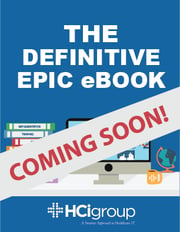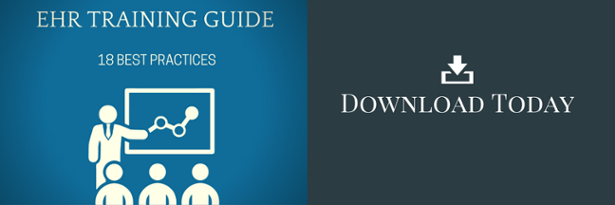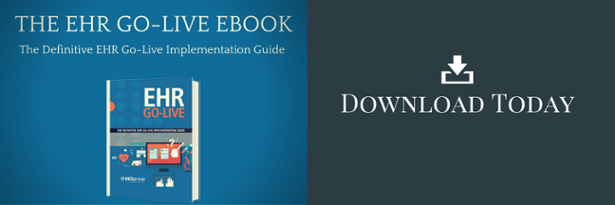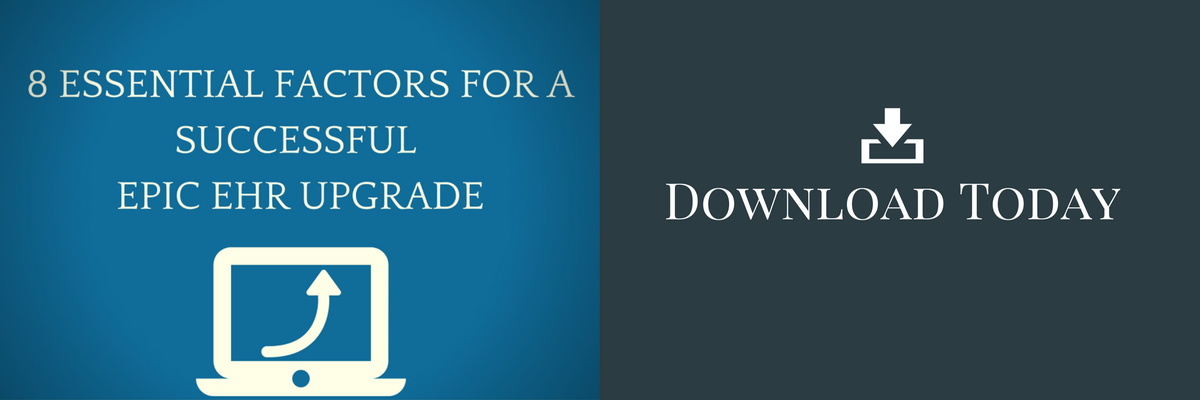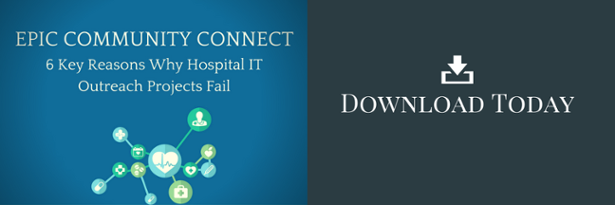You’ve Signed Epic: Now What?
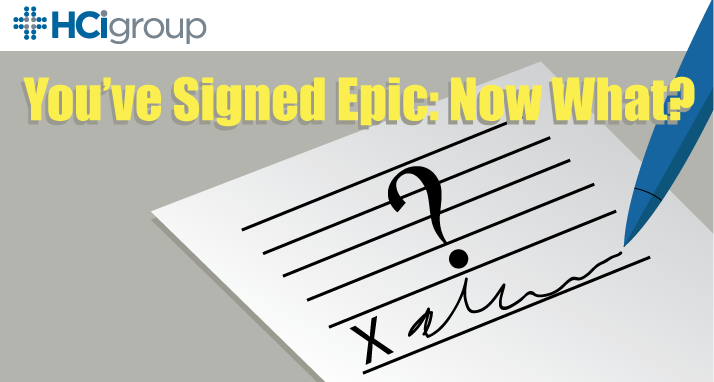
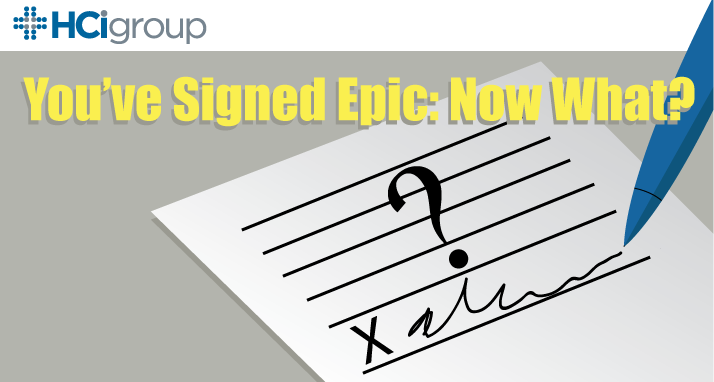
So, now that you’ve signed your Epic contract, what’s next?
We’ve gathered some of the best Epic subject matter experts (SME) in the industry to help guide you through the various stages of your project. Below, you’ll find their advice and recommendations stemming from innumerable hours spent managing Epic projects at organizations around the globe.
Epic Implementation Staffing Model
The gap between non-Epic-experienced FTEs and the resources required for a good implementation depends on one simple differentiator: exposure to the system. In many cases, the FTE build team is composed of techs and clinical experts without much, if any, exposure to an EMR. If this new Epic implementation is also an employee’s first implementation, that person will not have the benefit of learning from trial and error, will not have seen it built correctly or incorrectly, nor have seen the impact a certain build has on a workflow. The value a true Epic expert brings to the table is not only their successes, but also their mistakes. They know what to do and what NOT to do. They have seen what a good implementation looks like and know what it takes to optimize a workflow right from the start. Senior Epic experts keep the build pace on-time and within budget. The two most common solutions for building a competent team are bringing on seasoned Epic consultants and Temp-to-Perm (TTP) hires. Both of these models involve hiring highly experienced Epic experts. It will just depend on what suits your organization best in the long run. If you plan to build a team from the ground up, it often makes sense to have a blend of both consultants and TTP hires. If you are switching from another EMR to Epic, the buy-in and learning curve from the FTE staff will likely be much smoother and may only require implementation consultants.Inevitably, some of your internal resources will attend Epic training, but then won’t be able to pass the certification test. Keep in mind that earning an Epic certification is not an easy task. MANY have tried and failed, some multiple times. A lean build team cannot afford to lose a single member, as each member plays a crucial role. The enterprise team is typically composed of numerous smaller teams. These smaller teams work in conjunction with one another and rely on each other to do their job correctly and on time. To ensure the build isn’t compromised, the appropriate managers need to identify any and all gaps as soon as possible and take action to see that the gaps are closed. The quickest, most reliable, and ultimately the most cost effective, solution is to bring in a seasoned Epic expert with the required skills to pick up right where someone else left off. For an organization, the cost of a few short-term consultants is far cheaper than the cost of delaying the entire project. Think of this as a classic case of only being as strong as the weakest link.
As the project comes together, a common rate-limiting step is the build out of required interfaces. This demand is short lived but critical. At The HCI Group, we quickly identify such gaps in the build and budget and have developed a proven solution model that meets our clients’ needs through our HCI Integrate services. Our team of SME’s have experience managing this scope of work for hundreds of hospital systems around the country.
Epic Clinical Transformation
An investment in Epic comes with an expectation of Clinical Transformation. This will require organizational adoption and change management strategies. Achieving Clinical Transformation entails leveraging Clinical Workflow and processes, while assessing and promoting organizational readiness and emerging technologies into the current day healthcare environment. Clinical Transformation is an evolving and continuous effort that must include assessment and improvement in all aspects of patient care throughout your healthcare journey. Of course, quality clinical outcomes and patient safety are the primary goal.
Benefits Realization & Project Governance
For the CIO, alignment of the investment comparative to anticipated organizational benefits is critical. His or her role is to keep all facets of the organization apprised of progress tracking toward realization of benefits. Likewise, a functional, interdisciplinary governance structure that facilitates swift, empowered decision making at the appropriate levels of the organization is vital to meeting the project timelines.
One of the first steps to ensure that all planned project organizational benefits are realized occurs during the business case development phase. When estimating either quantitative benefits (e.g., improved financial performance and quality of care) or qualitative benefits (e.g., easier access to clinical data or improved clinical morale), it’s critical to verify that benefits can be measured. In order to measure benefits, it must be determined “who” will measure the benefits, “how” the benefits will be measured, and “where” the results will be documented. When organizations plan benefits without having adequate systems to store benefit information or without identifying functional accountability to measure and report benefit information, it’s often unclear whether benefit goals were reached. One way to maintain ongoing visibility of project benefit status is to track benefits throughout the entire project life cycle as part of the governance structure. This includes a brief benefit status agenda item on all project governance meetings that emphasizes the importance of project benefit realization to all stakeholders and facilitates proactive project benefit management. In addition, by structuring project governance meetings into multiple levels (e.g., project team to executive sponsors), project benefits thresholds can be defined, thereby enabling project teams to address lower impact issues and only escalate larger impact issues to the executive sponsors for action.
Epic Biomedical Device Integration
As with HL7 interfaces, another rate-limiting step is the lead time required to integrate biomedical devices into Epic. Regardless of the middleware chosen, it is key to define the scope of which devices will be included and prioritized. Additionally, an often overlooked and unanticipated cost is the need to upgrade and\or replace biomedical devices that are either incompatible or simply too old to integrate. Device integration for patient monitors and ventilators within the critical care and medsurg units is critical to workflow and nursing documentation.
Epic Data Conversions\Migrations
There is a good chance that your new Epic system will be displacing a legacy EMR that possesses clinically-relevant information. You’ll need to formulate a plan to migrate this data into Epic. This, of course, will require a specific skill set to accomplish.
Merely having the data is not the most important aspect of an EMR; it is imperative that you have quality data that can provide your healthcare professionals with the crucial information necessary to make the best patient safety decisions. Similarly, you need this information to make business related decisions that will provide a quicker return on investment and reimbursement models for future stability of the organization. When the discussion of data conversion begins, it is important to understand the reasoning behind the data conversion and the functional aspects for future use. By defining those elements, an understanding of what data is required for extraction begins to take shape. Managing the scope of data to migrate and the duration of the process is valuable criteria when working with a data conversion project. A good working definition of data conversion would be: Extracting and migrating data elements that are pertinent to current function and decision-making process of the new EMR solution.
Legacy Systems Support
As resources are trained, certified and shifted to the build efforts for implementation, you need a strategy for supporting the existing clinical systems. But, how can your current staff support the existing legacy system and implement a new EMR at the same time?
Now is the time to start looking at how you can shift the burden of legacy support off your current support team. One option is to outsource your legacy system support. You then have the benefit of a flexible and scalable legacy support model to address this challenge at a lower cost.
A good vendor partner will have the resources and the expertise necessary to ensure continuity of support within defined and agreed upon SLAs, allowing your staff to focus on implementing Epic. Additionally, an effective legacy system support service line will provide multi-disciplined, experienced analysts aimed at strengthening the overall Epic sustaining support model. Although these analysts may work remotely, they should be as much a part of your organization as an onsite resource, supporting your system 24x7.
It is best to utilize a customized approach to delivery that can be tailored to support as few or as many incoming tickets as required, whether that be filling the needs of a single application provision for a small hospital, or the ticket flow of a multi-facility, multi-application health system. This can be achieved by leverage existing resources, augmenting individual resources, or through the provision of a complete, turnkey managed services delivery model.
Allowing this increased bandwidth and focus on your new Epic implementation will help to ensure success and adoption for all end users.
Epic Training and Mobilization of the Workforce
The effort to train both the employed and contingent workforce is likely uncharted water for most organizations. Tying training as close as possible to go-live is an effort in not only the delivery of curriculum, but also an art in logistics management. Planning from the onset is key to an on-time and on-budget implementation. Note that, while core curriculum will be provided by the vendor, it is up to your organization to customize training to your workflows and patient population to make it relevant and meaningful. High impact complementary learning events such as Cyber Cafes, high fidelity simulation and multidisciplinary workflow labs should also be planned and offered.
Epic Go-Live
A well designed and executed training plan can easily be compromised by not giving adequate forethought to bridging the gap between classroom training and first use. Ensure that your super user program is developed with a level of accountability to guarantee that the right number of at-the-elbow (ATE) resources will be available at go-live. Once you’re up and running on the new Epic system, have a plan to sustain this program post go-live. Remember, advanced training doesn’t directly equate to making a super user “super.” Experience is necessary to guide clinicians and support staff through the critical first 2-4 weeks of activation.
Cyber Security
Building toward a future state Epic EMR requires a careful eye toward protecting ePHI that will be both in transit and at rest. You will need to ensure the appropriate level of access when the “glass is broken.” Without automation and sophisticated toolsets that extend well beyond the EMR, this quickly becomes an untrainable compliance burden. User and Entity Behavioral Analytics (UEBA) is the answer.
The EMR serves a critical role in facilitating both care and compliance. Unfortunately, it is also a key point risk in the care environment. Approaches including “break the glass” and robust logging offer the potential to isolate and reduce risk directly associated with an EMR, but fail to consider real comprehensive risk. Fortunately, machine learning solutions like UEBA can integrate and augment isolated approaches to provide full visibility of organizational risk. UEBA incorporates data from critical applications, including Epic, to provide a comprehensive understanding of the user and entity behavior. Because the system is built around machine learning, it evaluates behavior at all times, without the need for additional staffing. Furthermore, UEBA also integrates with your existing security solutions (SIM, DLP, AV, etc.) and provides a single view of real threat and risk in your environment.
Epic Upgrades & Operational Support
Energizing and moving the organization in lockstep toward a successful go-live is no small feat. However, the go-live is simply a milestone in the Epic journey and the first step toward benefits realization. A successful go-live is a short-lived accomplishment when operational support is not planned for and considered from the onset.
While upgrading may be the furthest thing from a CIO’s mind just after signing with Epic, it is a mistake to not begin considering your upgrade plan at this juncture. In order to reap the benefits of a function and feature-rich EMR such as Epic, the organization has committed itself to remaining current on new version releases. As you will need to stay within 2 versions of the most current release, be prepared to invest the time, effort, and cost it will require to upgrade approximately every 12-18 months. Each upgrade takes anywhere from six to nine months of planning, testing, training, execution, post-upgrade support, and optimization.
Above and beyond the benefit on new features and functions, you can also achieve higher levels of reimbursement from Epic’s Honor Roll program by upgrading to new versions. A full 20% of the yearly Honor Roll award is for Staying Current, which requires implementation of a current version and 70% of the enhancements and functionality on that version. Implementing the latest Epic Version with an upgrade also provides you with the framework for complying with regulatory and compliance updates (e.g. – Meaningful Use). In fact, Meaningful Use Stage 3 is not attainable with an Epic version earlier than 2016.
Epic Community Connect
One of the expected benefits of an investment in Epic is to leverage the technology as a relationship enabler for community physicians and community hospitals alike. There is no reason to delay the planning required to extend technology until after go-live. Building a successful connect program can and should start from the onset.
Community Connect is a strategic project with impacts and stakeholders throughout your organization. There are several ways of developing a connect program, but all successful extensions have included a significant program planning process to eliminate issues down the road which are costly both from an hours and public perception perspective. During a major hospital implementation, the local community of providers is usually a key group of stakeholders that can greatly increase the success of your implementation. By including Community Connect as a concurrent part of the Epic strategy, a host hospital can leverage the momentum gained by the implementation. Additionally, by including the community you can ensure they remain affiliated as strong referring partners throughout the transition. Standardizing the community on your technology platform will also ensure a smooth transition in record sharing and increase quality for the patient community.
Including CC as a part of an affiliate hospital expansion can also be strategically important. As design decisions are made around implementation of your new affiliate install, community providers associated with the affiliate hospital should be included in the strategy; again, ensuring strong relationships will maintain referral patterns and prevent the rebuilding of market share post-implementation. Including the community, along with the affiliate, is often perceived very favorably by the affiliate as well.
In short, much in the way that Epic is a key component of the overall technology strategy, Community Connect and Community Hospital programs should be integral to the Epic strategy. This will help ensure strong community relationships, facilitate business interactions, and bring about greater patient care quality.
Epic & HIMSS Stage 7
Presumably, a selection of Epic as the EMR comes with an expectation of alignment to the 7 Stages of HIMSS maturity. You should know what level will be achieved at the time of go-live and have a plan to ensure Stage 7 for both Inpatient and Ambulatory are attainable.
As of Q2 2016, HIMSS Analytics Logic data indicated just 4.5% of US acute care facilities were recognized as HIMSS Analytics EMR Adoption Model Stage 7 Award (Stage 7 Award) recipients. Following investment and implementation of the required technology, these Health IT leaders have established the people, process and organization related components necessary for pervasive adoption. Although EMR technology investment is front of mind for many organizations, Stage 7 Award recipients also have the organizational infrastructure in place to enable ongoing realization of benefits across areas of patient outcome, patient engagement, operational efficiency and/or quality and safety of care delivery process. Annual events including the Epic User Group Meeting and HIMSS Annual Conference & Exhibition routinely showcase these benefits and the organizations that have achieved them.
The HIMSS Analytics EMR Adoption Model provides an industry specific framework for organizations to identify opportunities to optimize the enablers of benefit realization, while measuring advances in technology adoption. As a capstone project to your Epic EMR implementation, achievement of the Stage 7 Award will deliver recognition of your organization’s place among the leaders in Health IT adoption. Partnering with the HCI Group is an opportunity to derive feedback on current state and identify actionable steps to strengthen alignment with the Stage 7 Award.
Although there are many additional details involved in a months-long Epic project, these 12 points will be a good starting place as you begin to plan for your implementation.
After countless hours of research, number crunching, and meetings between physician and executive leadership teams, your organization has finally selected Epic as the new EMR vendor. Congratulations, you’re now set to join some of the most prestigious hospitals and health systems in the world on your journey to clinical transformation through better technology!
Subscribe to Our Blog below to be notified when we release our Epic eBook.
